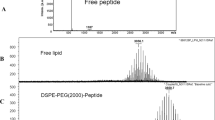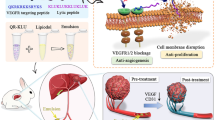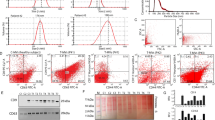Abstract
Cancer chemotherapy targeted to angiogenic vessels is expected to cause indirect tumor regression through the damage of the neovasculature without the induction of drug resistance. To develop a tool for neovasculature-specific drug delivery, we isolated novel peptides homing to angiogenic vessels formed by a dorsal air sac method from a phage-displayed peptide library. Three distinct phage clones that markedly accumulated in murine tumor xenografts presented PRPGAPLAGSWPGTS-, DRWRPALPVVLFPLH- or ASSSYPLIHWRPWAR-peptide respectively. After the determination of the epitope sequences of these peptides, we modified liposomes with epitope penta-peptides. Liposome modified with APRPG-peptide showed high accumulation in murine tumor xenografts, and APRPG-modified liposome encapsulating adriamycin effectively suppressed experimental tumor growth. Finally, specific binding of APRPG-modified liposome to human umbilical endothelial cells, and that of PRP-containing peptide to angiogenic vessels in human tumors, i.e., islet cell tumor and glioblastoma, were demonstrated. The present study indicates the usefulness of APRPG-peptide as a tool for anti-neovascular therapy, a novel modality of cancer treatment.
This is a preview of subscription content, access via your institution
Access options
Subscribe to this journal
Receive 50 print issues and online access
$259.00 per year
only $5.18 per issue
Buy this article
- Purchase on Springer Link
- Instant access to full article PDF
Prices may be subject to local taxes which are calculated during checkout




Similar content being viewed by others
References
Asahara T, Murohara T, Sullivan A, Silver M, van der Zee R, Li T, Witzenbichler B, Schatteman G, Isner JM . 1997 Science 275: 964–967
Asahara T, Takahashi T, Masuda H, Kalka C, Chen D, Iwaguro H, Inai Y, Silver M, Isner JM . 1999 EMBO J. 18: 3964–3972
Asai T, Kurohane K, Shuto S, Awano H, Matsuda A, Tsukada H, Namba Y, Okada S, Oku N . 1998 Biol. Pharm. Bull. 21: 766–771
Arap W, Pasqualini R, Ruoslahti E . 1998 Science 279: 377–380
Boehm T, Folkman J, Browder T, O'Reilly MS . 1997 Nature 390: 404–407
Browder T, Butterfield CE, Kraling BM, Shi B, Marshall B, O'Reilly MS, Folkman J . 2000 Cancer Res. 60: 1878–1886
Brower V . 1999 Nat Biotechnol. 17: 963–968
Brown JM, Giaccia AJ . 1998 Cancer Res. 58: 1408–1416
Cao Y, Linden P, Farnebo J, Cao R, Eriksson A, Kumar, V, Qi JH, Claesson-Welsh L, Alitalo K . 1998 Proc. Natl. Acad. Sci. USA 95: 14389–14394
Eliceiri BP, Cheresh DA . 1999 J. Clin. Invest. 103: 1227–1230
Gho YS, Lee JE, Oh KS, Bae DG, Chae CB . 1997 Cancer Res. 57: 3733–3740
Hanahan D . 1997 Science 277: 48–50
Healy JM, Murayama O, Maeda T, Yoshino K, Sekiguchi K, Kikuchi M . 1995 Biochemistry 34: 3948–3955
Huang X, Molema G, King S, Watkins L, Edgington TS, Thorpe PE . 1997 Science 275: 547–550
Ishikawa D, Kikkawa H, Ogino K, Hirabayashi Y, Oku N, Taki T . 1998 FEBS Lett. 441: 20–24
Ito H, Rovira II, Bloom ML, Takeda K, Ferrans VJ, Quyyumi AA, Finkel T . 1999 Cancer Res. 59: 5875–5877
Koivunen E, Gay DA, Ruoslahti E . 1993 J. Biol. Chem. 268: 20205–20210
Kurohane K, Tominaga A, Sato K, North JR, Namba Y, Oku N . 2001 Cancer Lett. 167: 49–56
Langer R . 1998 Nature 392: 5–10
Martens CL, Cwirla SE, Lee RY, Whitehorn E, Chen EY, Bakker A, Martin EL, Wagstrom C, Gopalan P, Smith CW, Tate E, Koller KJ, Schatz PJ, Dower WJ, Barrett RW . 1995 J. Biol. Chem. 270: 21129–21136
Nishi T, Budde RJA, McMurray JS, Obeyeskere NU, Safdar N, Levin VA, Saya H . 1996 FEBS Lett. 399: 237–240
Oku N . 1999a Adv. Drug Deliv. Rev. 40: 63–73
Oku N . 1999b Adv. Drug Deliv. Rev. 37: 53–61
Oku N, Doi K, Namba Y, Okada S . 1994 Int. J. Cancer 58: 415–419
Oku N, Namba Y, Okada S . 1992 Biochim. Biophys. Acta 1126: 255–260
O'Reilly MS, Holmgren L, Chen C, Folkman J . 1996 Nat. Med. 2: 689–692
Pasqualini R, Koivunen E, Ruoslahti E . 1997 Nat. Biotechnol. 15: 542–546
Pasqualini R, Ruoslahti E . 1996 Nature 380: 364–366
Scott JK, Smith GP . 1990 Science 249: 386–390
Skobe M, Rockwell P, Goldstein N, Vosseler S, Fusenig NE . 1997 Nat. Med. 3: 1222–1227
St Croix B, Rago C, Velculescu V, Traverso G, Romans KE, Montgomery E, Lal A, Riggins GJ, Lengauer C, Vogelstein B, Kinzler KW . 2000 Science 289: 1197–1202
Takikawa M, Kikkawa H, Asai T, Yamaguchi N, Ishikawa D, Tanaka M, Ogino K, Taki T, Oku N . 2000 FEBS Lett. 446: 381–384
Viti F, Tarli L, Giovannoni L, Zardi L, Neri D . 1999 Cancer Res. 59: 347–352
Zetter BR . 1997 Nat. Biotechnol. 15: 1243–1244
Acknowledgements
The authors thank Dr Yoji Ikawa at RIKEN for commenting on the manuscript. This work was supported in part by a Grant-in-Aid for Scientific Research from the Japan Society for the Promotion of Science and by Terumo Life Science Foundation. T Asai is a Research Fellow of the Japan Society for the Promotion of Science.
Author information
Authors and Affiliations
Corresponding author
Rights and permissions
About this article
Cite this article
Oku, N., Asai, T., Watanabe, K. et al. Anti-neovascular therapy using novel peptides homing to angiogenic vessels. Oncogene 21, 2662–2669 (2002). https://doi.org/10.1038/sj.onc.1205347
Received:
Revised:
Accepted:
Published:
Issue Date:
DOI: https://doi.org/10.1038/sj.onc.1205347
Keywords
This article is cited by
-
Advances in functional lipid nanoparticles: from drug delivery platforms to clinical applications
3 Biotech (2024)
-
Development of pro-apoptotic peptides as potential therapy for peritoneal endometriosis
Nature Communications (2014)
-
Advances in investigations on the mechanism of cancer multidrug resistance and the liposomes-based treatment strategy
Journal of Pharmaceutical Investigation (2014)
-
Identification of Peptide Ligands for Targeting to the Blood-Brain Barrier
Pharmaceutical Research (2010)



